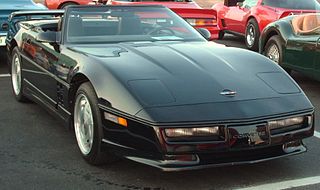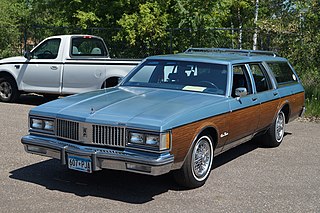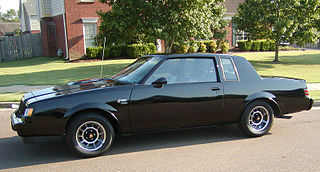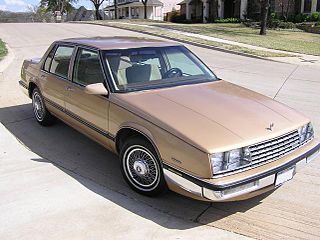
Oldsmobile or formally the Oldsmobile Division of General Motors was a brand of American automobiles, produced for most of its existence by General Motors. Originally established as "Olds Motor Vehicle Company" by Ransom E. Olds in 1897, it produced over 35 million vehicles, including at least 14 million built at its Lansing, Michigan factory alone. During its time as a division of General Motors, Oldsmobile slotted into the middle of GM's five divisions, and was noted for several groundbreaking technologies and designs.

Pontiac or formally the Pontiac Motor Division of General Motors, was an American automobile brand owned, manufactured, and commercialized by General Motors. Introduced as a companion make for GM's more expensive line of Oakland automobiles, Pontiac overtook Oakland in popularity and supplanted its parent brand entirely by 1933.

The Oldsmobile Cutlass was a series of automobiles produced by General Motors' Oldsmobile division between 1961 and 1999. At its introduction, the Cutlass was Oldsmobile's entry-level model; it began as a unibody compact car, but saw its greatest success as a body-on-frame intermediate. The Cutlass was named after the type of sword, which was common during the Age of Sail.

The Cadillac Cimarron is an entry-level luxury car manufactured and marketed by the Cadillac division of General Motors for model years 1982–1988 over a single generation, with a mild facelift in 1985.

In the automotive industry, rebadging is a form of market segmentation used by automobile manufacturers around the world. To allow for product differentiation without designing or engineering a new model or brand, a manufacturer creates a distinct automobile by applying a new "badge" or trademark to an existing product line.

The Y platform, or Y body, designation has been used twice by the General Motors Corporation to describe a series of vehicles all built on the same basic body and sharing many parts and characteristics. The first was for a group of entry-level compacts including the conventional front-engine compacts built by GM divisions Buick, Oldsmobile and Pontiac from 1961 to 1963. The second, and current, incarnation is used for a high-end rear-wheel drive sports-car platform from the 1970s through the 2000s.
The General Motors A platform was an automobile platform, and was GM's original, and oldest, platform used by all early GM products, beginning with the Chevrolet Superior. From this platform, all North American platforms B, C, and D were developed.

The W-platform was a General Motors automobile platform which underpinned both mid size and full-size front-wheel drive cars. Originally code named GM10, it began development in 1982 under Chairman Roger B. Smith and debuted in 1987 with the Pontiac Grand Prix, Buick Regal, and Oldsmobile Cutlass Supreme coupés. The four-door sedan version was introduced for 1990.

The General Motors N platform was a front-wheel drive compact automotive platform produced from 1984 to 2005. The GM N platform was based on the GM J-Body and replaced the GM X platform.

The B platform is a full-size rear-wheel drive car platform that was produced by General Motors (GM) from 1926 to 1996. Originally made for Oldsmobile and Buick, all of General Motors's five main makes would use it at some point. It was closely related to the original rear-wheel drive C and D platforms, and was used for convertibles, hardtops, coupes, sedans, and station wagons. With approximately 12,960,000 units built, divided across four marques, the 1965-70 B platform is the fourth best selling automobile platform in history after the Volkswagen Beetle, Ford Model T and the Fiat 124.

The Oldsmobile Custom Cruiser is an automobile that was manufactured and marketed by Oldsmobile in three generations from 1971 until 1992. The first full-size station wagon produced by Oldsmobile since the 1964 Oldsmobile 88 Fiesta, the Custom Cruiser was slotted above the intermediate Oldsmobile Vista Cruiser in size, and the mid-size Cutlass Supreme Cruiser that replaced it. The nameplate was first used by Oldsmobile from 1940 until 1947, denoting the top trim level of its C-body model line. 451,819 Custom Cruisers were sold over the years.

The Pontiac Parisienne is a full-size rear-wheel drive vehicle that was sold by Pontiac on the GM B platform in Canada from 1958 to 1986 and in the United States from 1983 to 1986. Right-hand drive models were locally assembled in Australia, New Zealand, and South Africa until 1969. For most of its run, the Canadian Parisienne was nearly mechanically identical to the American Chevrolet Impala or Chevrolet Caprice. The Parisienne wagon continued under the Safari nameplate until 1989. Parisienne or La Parisienne means a grammatically female person or thing from Paris, France.

The Turbo-Hydramatic 125 was the first in a line of automatic transmissions from General Motors designed for transverse engine application. Introduced in 1980, the line evolved into today's 4T40/45/65/80 line.

The General Motors G platform was an automobile platform designation used for mid-sized rear-wheel drive cars. It made its first appearance from the 1969 to 1972 model years, adapted from GM's A-body, and reappeared from 1982 to 1988. The second series of G-bodies began production designated as A-body cars in 1978, but were redesignated as G-body when the new front-wheel drive A-body platform was introduced in 1982.

The General Motors H platform is an automobile platform used by subcompact cars from the 1971 to 1980 model years. The first subcompact car design developed by GM, the rear-wheel drive H platform initially underpinned the Chevrolet Vega and its Pontiac Astre counterpart. For 1975, the H platform was expanded from entry-level vehicles to sport compacts, adding the Chevrolet Monza, Buick Skyhawk, Oldsmobile Starfire, and Pontiac Sunbird.

The H platform, or H-body designates a General Motors front-wheel-drive full-sized car platform introduced in 1986, and in most respects identical to the front-drive C platform introduced for model year 1985. Originally available in both 2-door and 4-door versions — the latter was more popular and two-door models dropped by 1992. Engines were predominantly the Buick's 3.8 liter V6 engine and later, GM's Buick 3800 V6; in naturally aspirated and supercharged variants.
The GM A platform was a rear wheel drive automobile platform designation used by General Motors from 1925 until 1959, and again from 1964 to 1981. In 1982, GM introduced a new front wheel drive A platform, and existing intermediate rear wheel drive products were redesignated as G-bodies.

The General Motors A platform was a mid-size platform designation used from 1982-1996. Previously the A body designation had been used for rear wheel drive mid-sized cars. They were initially offered alongside, but eventually supplanted rear-drive nameplates such as the Malibu for the intermediate class. Due to the strong popularity of the older rear wheel drive design, General Motors continued their production as the G-Body until 1988.
In the context of the automobile industry, downsizing is a practice used to transition vehicles from one size segment to another. Commenced during the Malaise era, downsizing is done in response to consumer and government demands influencing vehicle design. As vehicle product lines completed their model cycles, automobile manufacturers developed the next generation of a vehicle with a smaller exterior footprint to allow for weight reduction and increased fuel economy, using a shortened wheelbase and body length.

The General Motors X platform is an automobile platform designation that was used for compact cars with rear-wheel drive. Developed by Chevrolet, the architecture was produced from the 1962 to 1979 model years. During the 1970s, the platform was used by multiple GM divisions as the company expanded its use of compact model lines.
















